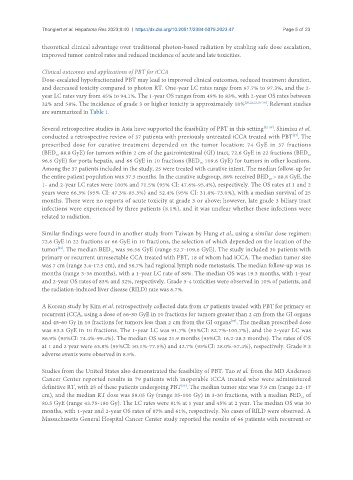Page 99 - Read Online
P. 99
Thonglert et al. Hepatoma Res 2023;9:40 https://dx.doi.org/10.20517/2394-5079.2023.47 Page 5 of 23
theoretical clinical advantage over traditional photon-based radiation by enabling safe dose escalation,
improved tumor control rates and reduced incidence of acute and late toxicities.
Clinical outcomes and applications of PBT for iCCA
Dose-escalated hypofractionated PBT may lead to improved clinical outcomes, reduced treatment duration,
and decreased toxicity compared to photon RT. One-year LC rates range from 67.7% to 97.3%, and the 2-
year LC rates vary from 45% to 94.1%. The 1-year OS ranges from 49% to 83%, with 2-year OS rates between
32% and 58%. The incidence of grade 3 or higher toxicity is approximately 10% [20,22,23,35-39] . Relevant studies
are summarized in Table 1.
Several retrospective studies in Asia have supported the feasibility of PBT in this setting [35-39] . Shimizu et al.
[37]
conducted a retrospective review of 37 patients with previously untreated iCCA treated with PBT . The
prescribed dose for curative treatment depended on the tumor location: 74 GyE in 37 fractions
(BED 88.8 GyE) for tumors within 2 cm of the gastrointestinal (GI) tract, 72.6 GyE in 22 fractions (BED
10
10
96.6 GyE) for porta hepatis, and 66 GyE in 10 fractions (BED 109.6 GyE) for tumors in other locations.
10
Among the 37 patients included in the study, 25 were treated with curative intent. The median follow-up for
the entire patient population was 37.5 months. In the curative subgroup, 88% received BED > 88.8 GyE, the
10
1- and 2-year LC rates were 100% and 71.5% (95% CI: 47.6%-95.4%), respectively. The OS rates at 1 and 2
years were 66.3% (95% CI: 47.3%-85.3%) and 52.4% (95% CI: 31.8%-73.0%), with a median survival of 25
months. There were no reports of acute toxicity at grade 3 or above; however, late grade 3 biliary tract
infections were experienced by three patients (8.1%), and it was unclear whether these infections were
related to radiation.
Similar findings were found in another study from Taiwan by Hung et al., using a similar dose regimen:
72.6 GyE in 22 fractions or 66 GyE in 10 fractions, the selection of which depended on the location of the
tumor . The median BED was 96.56 GyE (range 52.7-109.6 GyE). The study included 30 patients with
[38]
10
primary or recurrent unresectable CCA treated with PBT, 18 of whom had iCCA. The median tumor size
was 7 cm (range 3.4-17.5 cm), and 56.7% had regional lymph node metastasis. The median follow-up was 16
months (range 3-36 months), with a 1-year LC rate of 88%. The median OS was 19.3 months, with 1-year
and 2-year OS rates of 83% and 32%, respectively. Grade 3-4 toxicities were observed in 10% of patients, and
the radiation-induced liver disease (RILD) rate was 6.7%.
A Korean study by Kim et al. retrospectively collected data from 47 patients treated with PBT for primary or
recurrent iCCA, using a dose of 66-80 GyE in 10 fractions for tumors greater than 2 cm from the GI organs
and 45-60 Gy in 10 fractions for tumors less than 2 cm from the GI organs . The median prescribed dose
[39]
was 63.3 GyE in 10 fractions. The 1-year LC was 91.7% (95%CI: 82.7%-100.7%), and the 2-year LC was
86.9% (95%CI: 74.4%-99.4%). The median OS was 21.9 months (95%CI: 16.2-28.3 months). The rates of OS
at 1 and 2 year were 63.8% (95%CI: 50.1%-77.5%) and 42.7% (95%CI: 28.0%-57.4%), respectively. Grade ≥ 3
adverse events were observed in 8.5%.
Studies from the United States also demonstrated the feasibility of PBT. Tao et al. from the MD Anderson
Cancer Center reported results in 79 patients with inoperable iCCA treated who were administered
[23]
definitive RT, with 25 of these patients undergoing PBT . The median tumor size was 7.9 cm (range 2.2-17
cm), and the median RT dose was 58.05 Gy (range 35-100 Gy) in 3-30 fractions, with a median BED of
10
80.5 GyE (range 43.75-180 Gy). The LC rates were 81% at 1 year and 45% at 2 year. The median OS was 30
months, with 1-year and 2-year OS rates of 87% and 61%, respectively. No cases of RILD were observed. A
Massachusetts General Hospital Cancer Center study reported the results of 66 patients with recurrent or

